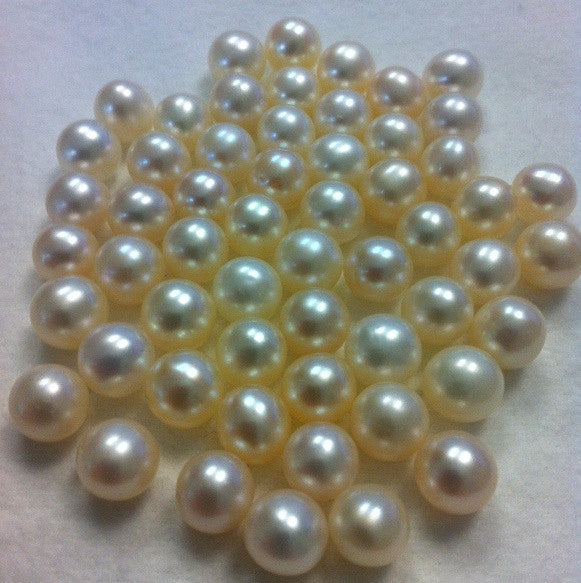Cleopatra, Mark Antony and Pliny's Pearls for Dinner
One of the most famous pearl stories of all time is that told by Pliny the Elder in his book, The Natural History of Pliny Volume 2. The story revolves around a bet Cleopatra made with Mark Antony.
From Pliny's own words:
When Antony had been sated by her, day after day, with the most exquisite banquets, this queenly courtesan, inflated with vanity and disdainful arrogance, affected to treat all this sumptuousness and all these vast preparations with the greatest contempt; upon which Antony enquired what there was that could possibly be added to such extraordinary magnificence. To this she made answer, that on a single entertainment she would expend ten millions of sesterces. Antony was extremely desirous to learn how that could be done, but looked upon it as a thing quite impossible; and a wager was the result.
Legend has it that Antony took this wager and the next day Cleopatra held a banquet.
In obedience to her instructions, the servants placed before her a single vessel, which was filled with vinegar, a liquid, the sharpness and strength of which is able to dissolve pearls. At this moment she was wearing in her ears those choicest and most rare and unique productions of Nature; and while Antony was waiting to see what she was going to do, taking one of them from out of her ear, she threw it into the vinegar, and after it was melted, swallowed it.
This sounds like an interesting wager and sort of like the "grain of sand in a pearl" myth, the story appears to be plausible. Pearls are composed of calcium carbonate and if you were to combine calcium carbonate with acetic acid (the main component of vinegar) the result would be calcium acetate water and carbon dioxide. In short, the pearls should melt!
Personally, I wasn't convinced. I'd never heard of vinegar getting splashed onto someone's strand of pearls and it melting off her neck like the Wicked Witch of the West. So this called for a experiment!
During the time of Cleopatra and Mark Antony, pearls were always naturals. I wouldn't want to take a chance destroying something as valuable as a natural pearl, but I could use non-nucleated cultured pearls. Pearls without an implanted bead don't much differ from their natural counterparts.
The pearls also must be completely untreated. Today's pearls are routinely bleached and pinked to even out the colors and add that slight hint of rose. I think it's safe to assume that Cleopatra's pearls were fine gems straight out of the shell!
It just so happens that every year we bring in four kilos of beadless cultured pearls that have had no treatments whatsoever - we call these pearls "raw material." We bring them in for a monastery that uses them in religious ceremonies. So when they ordered the last batch, I brought in an extra kilo for us to play with.
First, I selected out a handful of the nicest pearls. I chose pearls with fine natural luster, nice color and good shapes. Then I did the unthinkable. I dropped them in vinegar!
Untreated pearls before the vinegar test
Then came the hard part - the wait! I shook the container, had a stare-down with several pearls from the clear plastic side and waited some more. Pretty soon I got tired of waiting and found something else to do. It started to seem that Pliny's story wasn't completely true to history.
After two weeks (that's right, I waited two weeks), I decided that it was time to remove the pearls. I was convinced that the legend of Mark Antony and Cleopatra was exactly that - a legend. The story as told by Pliny simply could not be true. The speed at which a pearl dissolves in vinegar would have had them dining for months.
While my experiment was enough to convince me that the legend was a myth, I can state definitively that vinegar is not good for pearls. Take a look below to see what happens to pearls after two weeks in a tub of vinegar. They are nearly unrecognizable.
Pearls and vinegar certainly don't mix!








Interesting experiment! I also learned more about different types of pearls and that some religions use them for religious purposes.
Perhaps she simply swallowed the pearl! Granted, a 15mm plus would have been a challenge!
The vinegar did not dissolve the pearl but did destroy the pearl so in reality she did blow a huge amount of cash hence won the bet. Drinking the liquid was just theater.
You are assuming that the vinegar of today is equal in acidity to vinegar in those times. I don’t know anything about it, but that is the first thing that came to me. Commercial vinegar today is carefully held at 5%. Who knows what the handmade vinegar of yesteryear was?
Thank you, Jeremy for this timely answer. I suspected that soaking pearls in vinegar over dinner would not work. The level of acid in food grade vinegar is too low. If Cleopatra had used a higher grade of vinegar she would not have been able to consume it safely.
Leave a comment